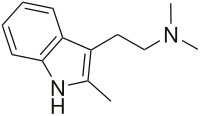From Wikipedia, the free encyclopedia
Chemical compound
Pharmaceutical compound
2,N,N -trimethyltryptamine , 2,N,N -TMT , or 2-Me-DMT is a tryptamine derivative that is a psychedelic drug. It was invented by Alexander Shulgin and reported in his book TiHKAL (#34).[ 1] 2A receptor target that mediates the hallucinogenic effects of these drugs.
Sweden's public health agency suggested classifying 2-Me-DMT as a hazardous substance, on May 15, 2019.[ 2]
Psychedelics (5-HT2A
Benzofurans Lyserg‐ Phenethyl‐
2C-x
3C-x 4C-x DOx HOT-x MDxx Mescaline (subst.) TMAs
TMA
TMA-2
TMA-3
TMA-4
TMA-5
TMA-6 Others
Piperazines Tryptamines
alpha -alkyltryptaminesx -DALT x -DET x -DiPT x -DMT
4,5-DHP-DMT 2,N,N-TMT 4-AcO-DMT 4-HO-5-MeO-DMT 4,N,N-TMT 4-Propionyloxy-DMT 5,6-diBr-DMT 5-AcO-DMT 5-Bromo-DMT 5-MeO-2,N ,N -TMT 5-MeO-4,N ,N -TMT 5-MeO-α,N,N-TMT 5-MeO-DMT 5-N ,N -TMT 7,N,N-TMT α,N,N-TMT (Bufotenin) 5-HO-DMT DMT Norbaeocystin (Psilocin) 4-HO-DMT (Psilocybin) 4-PO-DMT x -DPT Ibogaine-related x -MET x -MiPT Others
Others
Dissociatives (NMDAR antagonists )
Deliriants (mAChR antagonists ) Others
Tryptamines
1-Methylpsilocin 2-HO-NMT 2-Me-DET 2-Methyl-5-HT 2,N ,N -TMT 4,5-DHP-DMT 4-AcO-DALT 4-AcO-DET 4-AcO-DiPT 4-AcO-DPT 4-AcO-EPT 4-AcO-MALT 4-AcO-MET 4-AcO-MiPT 4-AcO-NMT 4-AcO-TMT 4-F-5-MeO-DMT 4-HO-5-MeO-DMT 4-HO-DALT 4-HO-DBT 4-HO-DET 4-HO-DiPT 4-HO-DPT 4-HO-DSBT 4-HO-EPT 4-HO-MALT 4-HO-MET 4-HO-McPT 4-HO-McPeT 4-HO-MiPT 4-HO-MPT 4-HO-MsBT 4-HO-NALT 4-HO-NMT 4-HO-PiPT 4-HO-pyr-T 4-HO-TMT 4-HT 4-MeO-DiPT 4-MeO-DMT 4-MeO-MiPT 4-PrO-DMT 4,5-MDO-DMT 4,5-MDO-DiPT 5-BT 5-Bromo-DMT 5-CT 5-Chloro-DMT 5-Ethoxy-DMT 5-Ethyl-DMT 5-Fluoro-DET 5-Fluoro-DMT 5-Fluoro-EPT 5-Fluoro-MET 5-HO-DiPT 5-HTP (oxitriptan) 5-MeO-2-TMT 5-MeO-34MPEMT 5-MeO-7,N ,N -TMT 5-MeO-DALT 5-MeO-DBT 5-MeO-DET 5-MeO-DiPT 5-MeO-DMT 5-MeO-DPT 5-MeO-EiPT 5-MeO-EPT 5-MeO-MALT 5-MeO-MET 5-MeO-MiPT 5-MeO-NMT 5-MeO-pyr-T 5-MeO-NBpBrT 5-MeO-T-NBOMe 5-MeS-DMT 5-Methoxytryptamine (5-MT; mexamine) 5-Methyl-DMT 5-Methyltryptamine 5-MT-NB3OMe 5-(Nonyloxy)tryptamine 5,6-MeO-MiPT 5,6-MDO-DiPT 5,6-MDO-DMT 5,6-MDO-MiPT 5,6-DHT 5,7-DHT 6-Fluoro-DMT 6-MeO-DMT 7-Methyl-DMT Acetryptine (5-AT) Aeruginascin (4-PO-TMT) AGH-107 AGH-192 AH-494 ALiPT Alpertine Baeocystin (4-PO-NMT) Benzotript (4-chlorobenzoyl-L -tryptophan) Bufotenidine (5-HTQ) Bufotenin (5-HO-DMT) Convolutindole A CP-132,484 DALT DBT Desformylflustrabromine DET DiPT DMT DPT E-6801 E-6837 EiPT EMDT EPT Ethocybin (4-PO-DET) FGIN-127 FGIN-143 FT-104 HIOC Idalopirdine Indolylethylfentanyl Indorenate Iprocin (4-HO-DiPT) Lespedamine MET Methylbutyltryptamine Miprocin (4-HO-MiPT) MiPT MPT Milipertine MS-245 MSBT N -Feruloylserotonin (moschamine)NET NMT Norbaeocystin (4-PO-T) NTBT O-4310 O -PivalylbufotenineOxypertine PiPT Psilacetin (O -acetylpsilocin; 4-AcO-DMT) Psilocin (4-HO-DMT) Psilocybin (4-PO-DMT) Pyr-T RS134-49 Serotonin (5-HT) Solypertine ST-1936 Tryptamine Tryptophan Yuremamine Z2876442907 N -Acetyltryptaminesα-Alkyltryptamines
2,α-DMT 4-HO-αMT 4-HO-MPMI (lucigenol) 4-Me-αET 4-Me-αMT 5-Chloro-αMT 5-Ethoxy-αMT 5-Fluoro-αET 5-Fluoro-αMT 5-iPrO-αMT 5-MeO-α,N ,N -TMT 5-MeO-αET 5-MeO-αMT 5-MeO-MPMI 5-Methyl-αET 6-Fluoro-αMT 7-Chloro-αMT 7-Methyl-αET α-Methyl-5-HTP α-Methylmelatonin α-Methylserotonin (5-HO-αMT) α-Methyltryptophan (αMTP) α,N -DMT (N -methyl-αMT) α,N ,N -TMT α,N ,O -TMS αET (etryptamine) αMT AL-37350A (4,5-DHP-αMT) BNC-210 BW-723C86 CP-135807 IPAP (α,N -DPT) MPMI Triptans Cyclized tryptamines
Bay R 1531 Ciclindole Cyclic 3-OHM Ergolines and lysergamides (e.g., LSD )Flucindole Harmala alkaloidsβ-carbolines (e.g., 6-MeO-THH , 9-Me-BC , β-carboline (norharman) , harmaline , harmalol , harmane , harmine , pinoline , tetrahydroharmine , tryptoline )Iboga alkaloidsDM-506 (ibogaminalog) , ibogaine , ibogamine , noribogaine , tabernanthalog , tabernanthine )Metralindole NDTDI PHA-57378 PNU-22394 PNU-181731 RU-28306 Yohimbans (e.g., yohimbine , rauwolscine , spegatrine , corynanthine , ajmalicine , reserpine , deserpidine , rescinnamine ) Related compounds

